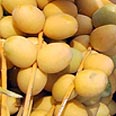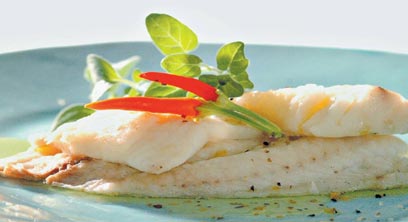
Galilean delicacies
Two treats from the Galilee – tilapia (St. Peter’s fish) and dates – combine into a Biblically inspired meal
Tilapia (St. Peter’s fish)
Locals refer to tilapia as either “amnon” in Hebrew or “musht” in Arabic. In fact, “amnon” is actually from the Aramaic; “am” means mother, and “nun” means fish. The name’s definition refers to the fish’s unique manner of caring for its young.
Tilapias are mouth-brooders. In other words, after the female lays her eggs in a nest which the male prepares, she carries them in her mouth. Even after the fry hatch, the female does not release them until they are one centimeter long and thus able to fend for themselves.
Legend has it that the tilapia was involved in the Christian miracle of the loaves and fishes (hence, the name “St. Peter’s fish”). In any event, the tilapia is certainly a veteran Galilean resident; the fish appears prominently in antique mosaics discovered in ancient synagogues and churches.
Raised in both fishponds and organically, the delicious tilapia is highly suitable for light and dietetic cooking – as long as one avoids oil-rich sauces, of course. Like any fish, tilapia is best after the briefest possible stay in the skillet or oven.
One of the simplest ways to prepare tilapia is in the microwave. Recently, supermarket freezer sections have begun stocking ready-to-cook tilapia fillets, both with and without spices, which are worth purchasing.
Dates
A symbol of the Land of Israel, the date is one of the Biblical Seven Species and a prominent element of traditional local cuisine. Similar to the Land of Israel itself, local dates blossomed during Biblical times, flourished during the Roman era, and practically disappeared in the wake of the Judean exile.
The current abundance of local dates can be attributed to the pioneers of the Second Aliyah, who planted date trees adjacent to the Kinneret, and to Kvutzat Kinneret members Ben-Zion Yisraeli and Shmuel Stoller, who continued to cultivate the date.
Dates were used as sweeteners way before white sugar became popular. Apparently, the Biblical “honey” was actually silan, or date honey.
In addition to enhancing beverages, candies, and baked goods, the sweetness of silan and the date itself complements beef, poultry, and even fish. Today’s market teems with dried dates, juicy dates, silan, pastes, and date-based spices.
Recipes
Here are some basic microwave recipes for whole as well as filleted tilapia. Microwaving is the simplest, quickest, and most convenient way to prepare this fish as well as to preserve its natural flavors.
You can add your favorite sauces and spices to these recipes in order to soar to gastronomic heights. Alternatively, you can play it safe with olive oil, lemon juice, salt, and pepper, or enjoy one of the date-based sauces listed below.
Microwave Tilapia
Serves: 4
Ingredients:
2-4 tilapias (about 2½ pounds of fish)
3 TBSP olive or walnut oil
Salt
Pepper
Directions:
Rub the tilapias with oil, both on the inside and the outside. Sprinkle with salt and pepper, and place in a covered microwave-safe dish. Cook covered, on high, for approximately 8 minutes. Turn the fish over, and cook for an additional 8 minutes. The fish is done when the flesh is opaque and crumbles at the touch of a fork.

Microwave Tilapia Fillets
Serves: 4
Ingredients:
8 small tilapia fillets – fresh or frozen (about 1¼ to 1½ pounds of fish)
Salt
Pepper
Directions:
If the fillets are frozen, there is no need to defrost them. Place the fillets in a microwave-safe dish, and sprinkle with salt and pepper. Cover with a slotted lid. Microwave 1 minute for each fillet (2 minutes if the fillets are frozen). Turn the fillets over halfway through the cooking. The fish is ready when the flesh is opaque white and crumbles at the touch of a fork.
Serve with olive oil, lemon juice, salt, and pepper. Chopped fresh herbs - such as za’atar (hyssop), parsley, basil, thyme, oregano, sage, or tarragon - are a nice addition. Garnish with hot pepper, if desired.
Olive Oil and Silan Marinade
Ingredients:
1/3 cup olive oil
2 TBSP silan (date honey)
¼ cup lemon juice
1 tsp mustard
Salt
Pepper
Garnish: Fresh za’atar (hyssop) leaves (optional)
Directions:
Place all the ingredients in a cruet. Seal and shake well. Pour over fish, and garnish with za’atar leaves, if desired.
Spicy Date Sauce
Ingredients:
¼ cup oil
1 TBSP date paste
¼ cup rice vinegar
2 TBSP soy sauce
Hot pepper sauce or Tabasco sauce, to taste
Directions:
In a small pot, heat oil, date paste, vinegar, and soy sauce. Bring to boil while stirring constantly. Let boil for 1-2 minutes, and add hot pepper sauce or Tabasco sauce to taste. Remove from flame, and pour over cooked fish.
Basil, Wine, and Silan Sauce
Ingredients:
1 large batch of basil
4 peeled garlic cloves
3 TBSP olive oil
2 TBSP lemon juice
1 cup white wine
1 TBSP silan (date honey)
Salt
Pepper
Directions:
Remove the basil leaves from the stems. Rinse well, and pat dry. Place leaves in food processor or blender. (Use at least 1½ cups of packed leaves.) Add garlic cloves, oil, and lemon juice, and puree until smooth.
Boil wine in a small pot for around 3 minutes. Add the basil puree. Mix well, and return to boil over a low flame. Add generous amounts of salt and pepper. Pour sauce over cooked fish.
Variation: Use parsley or coriander (cilantro) in place of the basil.










